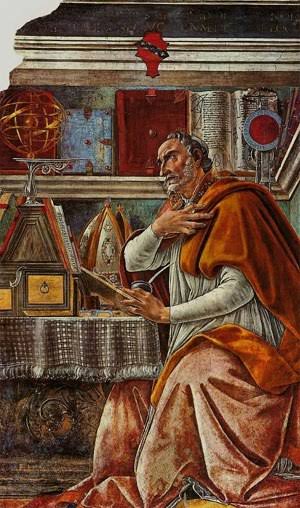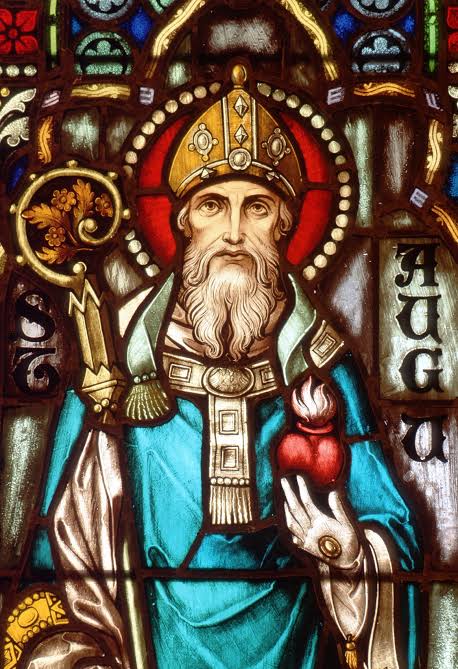St. Augustine was born ‘Aurelius Augustinus’ in 354 AD in Thagaste, Numidia (now Souk Ahras, Algeria). He was born into an upper-class family. His father Patricius was a pagan, though he converted to Christianity on his deathbed. His mother St. Monica was a Christian and she raised Augustine in the faith, though he was not baptized until he was an adult.
He’s one of the most influential Church Fathers and theologians in history, but wasn’t always a firm believer in the Christian faith.As a boy he became conscious of sin in a special way when he participated in a pointless act of theft. This made a profound impression on him and he later described how he regretted it in his renowned spiritual autobiography ‘The Confessions’.
St. Augustine partook in what St. Paul delicately called “youthful passions” (2 Timothy 2:22).When he was 19, he began a long-term affair with a woman.She was not of Augustine’s social class so he never married her. Besides, St. Monica objected to him marrying a woman of lower status. She (his lover) did, however, give Augustine a son, who was named Adeodatus (Latin, “Gift of God”).
Despite his Christian upbringing, Augustine abandoned the faith and became a Manichean(a Gnostic, dualistic sect founded in the A.D. 200s by an Iranian man named Mani)which crushed his mother. Although he derailed in his faith, St. Monica never relented and continued to pressurize him to stay in contact with Christians and Christian literature. He tended to her advice and took aposition teaching rhetoric in Milan, Italy.

One day, in the summer of 386, he heard a childlike voice chanting “Tolle, lege” (Latin, “Take, read”). He took this as a divine command and opened the Bible, randomly, to Romans 13:13-14, which read:
Let us conduct ourselves becomingly as in the day, not in reveling and drunkenness, not in debauchery and licentiousness, not in quarreling and jealousy. But put on the Lord Jesus Christ, and make no provision for the flesh, to gratify its desires.
Applying this to his life, Augustine was cut to the heart and his conversion now began in earnest. He was baptized, along with his son (Adeodatus), at the next Easter Vigil. St. Ambrose of Milan baptized both of them.
In 388, Augustine, Monica, and Adeodatus prepared to return to North Africa. Unfortunately, Monica only made it as far as Ostia, the port of Rome, where she passed away. In Africa, Adeodatus passed away also. This left Augustine alone on the family property. He sold almost all his possessions and gave the money to the poor. He did, however, retain the family house, which he turned into a monastery.
In 391, he was ordained a priest of the diocese of Hippo(now Annaba, Algeria).
In 395, he became the city’s coadjutor bishop and then its bishop.
As bishop, he wrote extensively and the value of his writings was such that he became a Church Father.
Augustine passed away on Aug. 28, 430 (hence his feast day of Aug. 28).
At the time, Hippo was being sacked by Arian Vandals, whom after his death burned the city, but they left Augustine’s cathedral and library untouched.
Augustine was canonized by popular acclaim, as the custom of papal canonization had not yet arisen then. He was named a doctor because of the extraordinarily high value of his writings, which include major theological, philosophical, and spiritual works.
Among his most famous works are:
The Confessions (his spiritual autobiography)
Handbook on Faith, Hope, and Love.

Interesting Facts about St. Augustine
St. Augustine of Hippo had a huge impact on the Catholic Church, and the world at large. Some facts I bet you had no clue about are listed below:
Augusta, FL is named after St. Augustine and Santa Monica, CA is named after his mother.
His words are quoted in St. Thomas Aquinas’ writings on nearly every page.
Augustine spent his life fighting the great heresies of the Manicheans, Pelagians, Arians, and Donatists.
Augustine did not want to be a bishop so he avoided going to towns where a bishop was needed. He founded his monastery in Hippo where Valerius was bishop, but was immediately made his auxiliary bishop.
He worked with St. Jerome on the New Testament Vulgate and is largely responsible for the inclusion of Hebrews and Revelation into the Bible.
He was the first theologian to say that men and women were both equal and made in the image of God.
Augustine taught in North Africa, Rome and Milan.
He published nearly 5 million words before the printing press.
The First Catholic University in Lagos, Nigeria is named after St. Augustine.
- Ireroa Collins (ECO ’19)